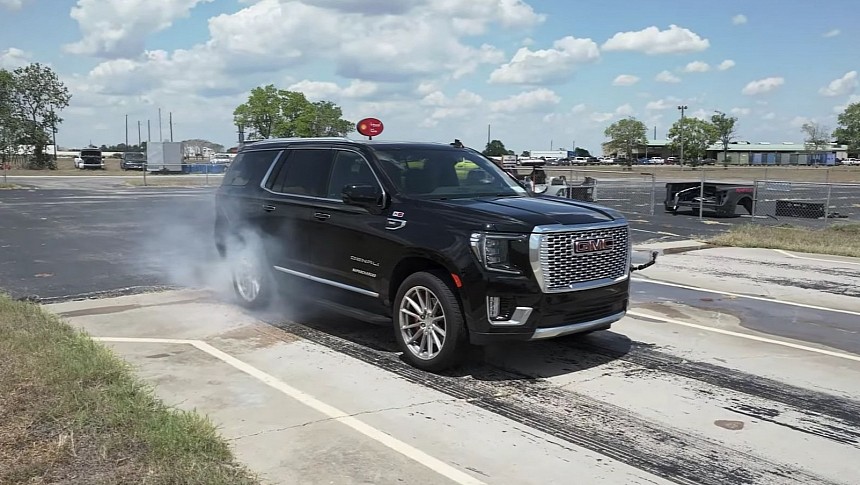If the Cadillac Escalade-V seems too expensive for a truck-based sport utility vehicle worthy of being called sporty, fret not. Hennessey Performance Engineering charges $27,950 to upgrade the Escalade's GMC-branded cousin with a thumpin' great blower, pushing the 6.2-liter small block to 650 horsepower and 658 pound-feet (892 Nm) of twist.
At press time, a Denali with four-wheel drive retails at $79,200. Plus $27,950 for the supercharger, and you'll get $107,150 rather than $151,090 for the Escalade-V. The sound alone makes the Hennessey H650 upgrade worth it, a sound that's made possible by a cat-back exhaust made from stainless steel. The factory tips are retained, though, for a clean look.
Referred to as L87, the small-block V8 also rocks chromoly hardened pushrods, high-flow induction, and high-flow intercooling. Hennessey further sweetens the deal with a crankcase ventilation system and – of course – a proprietary ECU calibration.
Advertised under the H650 moniker, the supercharged upgrade package includes all necessary gaskets and fluids, up to 500 miles of testing on the road, chassis testing, a few badges, and an underhood plaque with the serial number of the vehicle. The black-painted Yukon Denali in the video below, for example, is number 006. Every build is covered by three years or 36,000 miles of limited warranty.
22-inch Performance wheels (either black or polished silver) and brakes are optionally available. Also worthy of note, upgrading the Yukon Denali at Hennessey removes the cylinder deactivation and auto start/stop features permanently. In the L87's case, the cylinder deactivation feature is known as Dynamic Fuel Management in GM's vernacular.
DFM succeeds Active Fuel Management, and the biggest difference between them is the number of cylinder patterns. Both the 5.3- and 6.2-liter small blocks can operate a variety of cylinders, depending on the scenario, right down to just one cylinder. AFM, by comparison, shuts off four cylinders.
Even though Chrysler intends to pull the plug on the HEMI after the 2024 model year, General Motors will continue making small blocks for as long as possible. The biggest automaker of the Big Three in Detroit will invest millions over millions of dollars into Flint Engine Operations in Michigan to prepare the facility for the next-generation small block.
Other than the $579 million going into said production facility, we don't know much about the LT's heir apparent. On the other hand, we're pretty certain that GM will continue offering free-breathing small blocks in full-size pickups and the 'Vette.
At press time, GM's most powerful series-production vehicle to feature a small block is the Escalade-V (682 horsepower). In terms of peak torque, make that CT5-V Blacking (659 pound-feet or 893 Nm). From a historical perspective, the seventh-generation Corvette ZR1 sported the most powerful series-production small block in the form of the LT5 (755 horsepower and 715 pound-feet or 969 Nm).
How could GM squeeze out so much from 6.2 liters despite the engine's two-valve-per-cylinder setup? For starters, a 2.6-liter supercharger as opposed to 1.7 for the seventh-generation Corvette Z06. The most important aspect of the LT5, however, is dual injection. To maximize performance and efficiency, chances are the next-gen small block will also transition from direct injection to dual injection.
Referred to as L87, the small-block V8 also rocks chromoly hardened pushrods, high-flow induction, and high-flow intercooling. Hennessey further sweetens the deal with a crankcase ventilation system and – of course – a proprietary ECU calibration.
Advertised under the H650 moniker, the supercharged upgrade package includes all necessary gaskets and fluids, up to 500 miles of testing on the road, chassis testing, a few badges, and an underhood plaque with the serial number of the vehicle. The black-painted Yukon Denali in the video below, for example, is number 006. Every build is covered by three years or 36,000 miles of limited warranty.
22-inch Performance wheels (either black or polished silver) and brakes are optionally available. Also worthy of note, upgrading the Yukon Denali at Hennessey removes the cylinder deactivation and auto start/stop features permanently. In the L87's case, the cylinder deactivation feature is known as Dynamic Fuel Management in GM's vernacular.
DFM succeeds Active Fuel Management, and the biggest difference between them is the number of cylinder patterns. Both the 5.3- and 6.2-liter small blocks can operate a variety of cylinders, depending on the scenario, right down to just one cylinder. AFM, by comparison, shuts off four cylinders.
Even though Chrysler intends to pull the plug on the HEMI after the 2024 model year, General Motors will continue making small blocks for as long as possible. The biggest automaker of the Big Three in Detroit will invest millions over millions of dollars into Flint Engine Operations in Michigan to prepare the facility for the next-generation small block.
Other than the $579 million going into said production facility, we don't know much about the LT's heir apparent. On the other hand, we're pretty certain that GM will continue offering free-breathing small blocks in full-size pickups and the 'Vette.
At press time, GM's most powerful series-production vehicle to feature a small block is the Escalade-V (682 horsepower). In terms of peak torque, make that CT5-V Blacking (659 pound-feet or 893 Nm). From a historical perspective, the seventh-generation Corvette ZR1 sported the most powerful series-production small block in the form of the LT5 (755 horsepower and 715 pound-feet or 969 Nm).
How could GM squeeze out so much from 6.2 liters despite the engine's two-valve-per-cylinder setup? For starters, a 2.6-liter supercharger as opposed to 1.7 for the seventh-generation Corvette Z06. The most important aspect of the LT5, however, is dual injection. To maximize performance and efficiency, chances are the next-gen small block will also transition from direct injection to dual injection.









